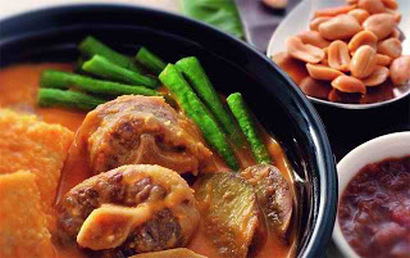
Kare-kare is a Philippine stew. It is made from peanut sauce with a variety of vegetables, stewed oxtail, beef, and occasionally offal or tripe. Meat variants may include goat meat or (rarely) chicken. It is often eaten with bagoong (shrimp paste), sometimes spiced with chili, and sprinkled with calamansi juice. Traditionally, any Filipino fiesta (particularly in Pampanga region) is not complete without kare-kare. In some Filipino-American versions of the dish, oxtail is exclusively used as the meat.
As with many things in the Philippines, there are several stories as to the origins of this rather unusual yet distinctly Filipino dish. The first one is that it came from Pampanga. Another, from the regal dishes of the Moro elite who once settled in Manila before the Spanish arrival (interestingly enough, in Sulu and Tawi-Tawi, Kare-kare also remains a popular dish). It's a comfort food for Filipinos, and is a perennial family favorite in both local and overseas Filipino households.
Source: http://en.wikipedia.org/wiki/Kare-kare
Source: http://en.wikipedia.org/wiki/Kare-kare
Ingredients
|
|
Procedure
1. In a stock pot, boil beef, tripe and oxtails in water for an hour or until cooked. Strain and keep the stock.
2. In a big pan or wok, heat oil and atsuete oil.
3. Sauté garlic, onions until golden brown, then add the stock, toasted rice, beef, oxtail and peanut butter.
4. Bring to a boil and simmer for 15 minutes. Salt to taste.
5. Add the eggplant, string beans, pechay and banana bud and ook the vegetables for a few minutes
6. Do not overcook the vegetables.
7. Serve with bagoong on the side and hot plain rice.
2. In a big pan or wok, heat oil and atsuete oil.
3. Sauté garlic, onions until golden brown, then add the stock, toasted rice, beef, oxtail and peanut butter.
4. Bring to a boil and simmer for 15 minutes. Salt to taste.
5. Add the eggplant, string beans, pechay and banana bud and ook the vegetables for a few minutes
6. Do not overcook the vegetables.
7. Serve with bagoong on the side and hot plain rice.



